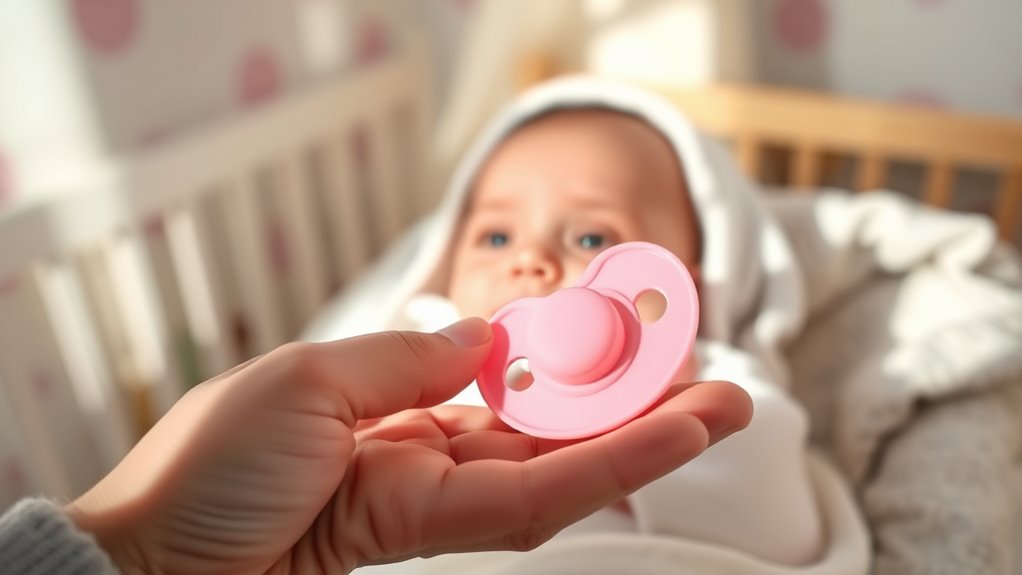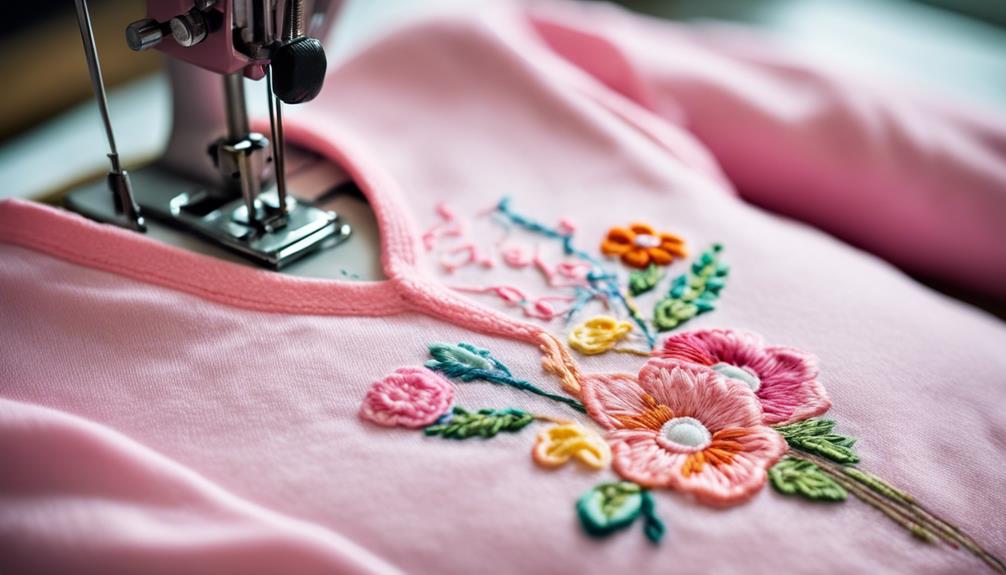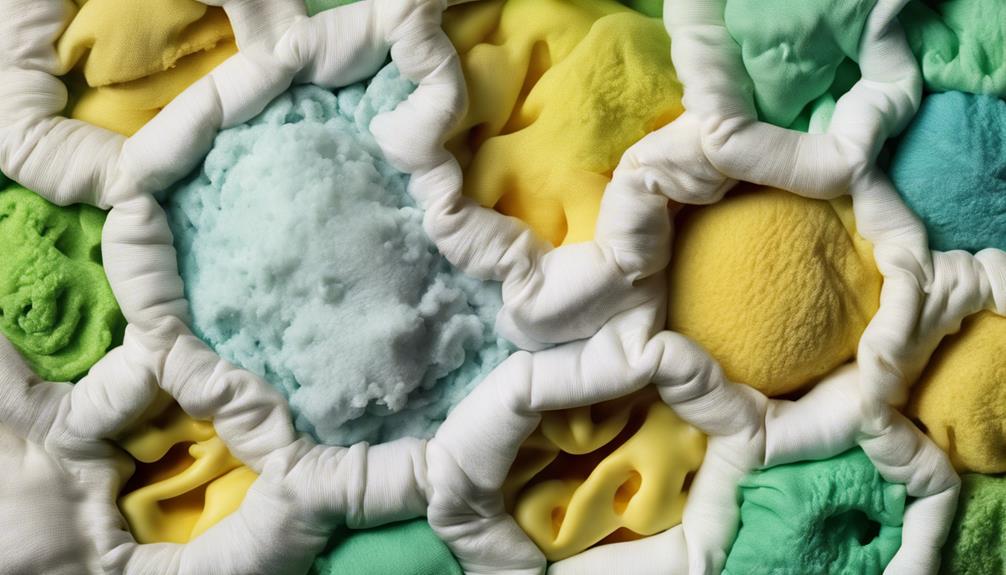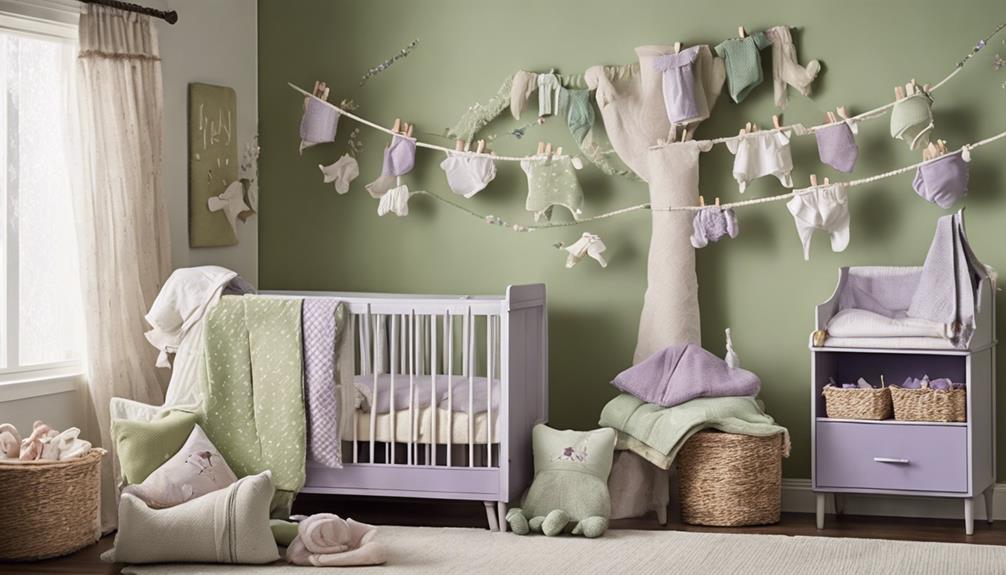You can usually introduce a pacifier between 4 to 6 weeks when your baby shows signs of seeking comfort, like hand-to-mouth movements or interest in soothing objects. Use a gentle approach, offering it after feedings or during calming moments, ensuring it’s the right size for your baby’s age. Choose safe materials and keep it clean. For more tips on making the introduction smooth and managing use, stay tuned for helpful details.
Key Takeaways
- Introduce pacifiers between 4 to 6 weeks when babies seek comfort beyond feeding.
- Wait until breastfeeding is well established before offering a pacifier.
- Choose age-appropriate, safe materials like silicone or latex, and ensure proper size for your baby.
- Offer the pacifier gently during calm moments, avoiding coercion, and observe the baby’s cues for readiness.
- Maintain hygiene through regular cleaning, inspection, and store in clean, designated containers for safety.
Understanding the Benefits and Considerations of Pacifiers

Pacifiers can offer several benefits for both babies and parents, making them a popular soothing tool. They can help calm your baby, reducing fussiness and promoting comfort. Using a pacifier may also support better sleep patterns, helping your little one settle more easily and stay asleep longer. Additionally, pacifiers are generally safe when used appropriately, and they can decrease the risk of Sudden Infant Death Syndrome (SIDS). Proper pacifier hygiene is essential to prevent germ transmission and ensure safety. It is also helpful to be aware of the holistic approaches to health and wellness that can influence how pacifiers are used within a broader context of nurturing care. By understanding these benefits and considerations, you can decide when and how to introduce a pacifier that best supports your baby’s needs while safeguarding their long-term oral health.
Recognizing the Right Time to Offer a Pacifier
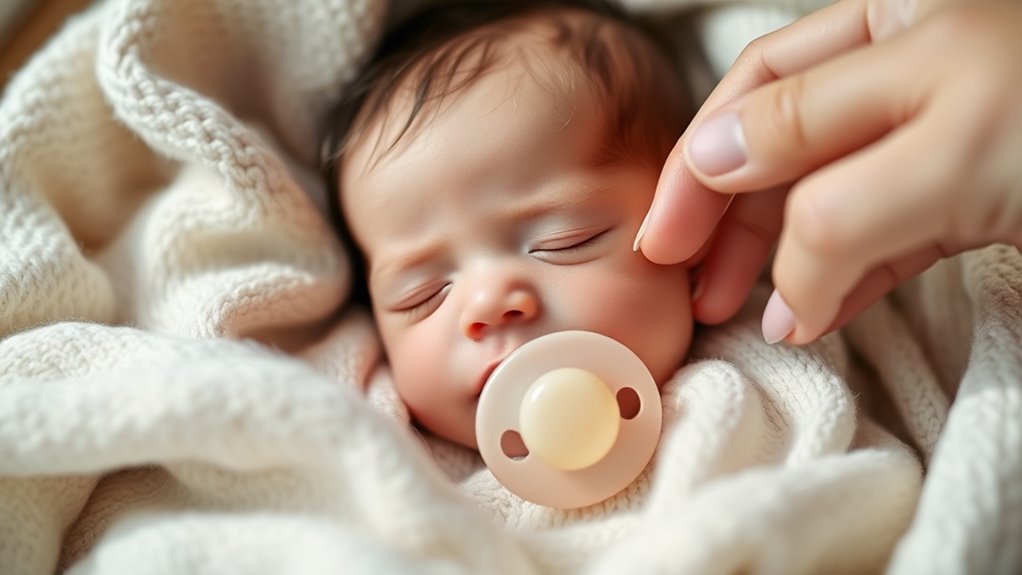
You’ll want to watch for signs your baby is ready for a pacifier, like rooting or sucking on their fingers. The ideal age window is usually between 4 and 6 weeks, when they start seeking comfort beyond feeding. Recognizing these cues helps you introduce the pacifier at the right moment for your baby’s needs. Being aware of newborn sleep patterns can also provide additional insights into infant comfort strategies. Understanding emotional regulation development can further guide you in supporting your baby’s self-soothing behaviors.
Signs of Readiness
Knowing when your baby is ready for a pacifier can make the shift smoother. Watch for signs like your baby showing interest in soothing objects or bringing their hand to their mouth frequently. If they start thumb sucking habits that seem persistent or intense, it might indicate they’re seeking comfort and could benefit from a pacifier. Also, consider their oral development; if your baby is able to latch onto a pacifier comfortably and can hold it in their mouth without difficulty, it shows readiness. At this stage, your little one is likely developing the coordination needed for pacifier use. Recognizing these signs helps guarantee the pacifier provides comfort without interfering with natural thumb sucking habits or oral growth. Additionally, understanding the importance of oral development can help determine if your baby is physically prepared for a pacifier. Introducing a pacifier at the right time can also support healthy oral motor skills development, which are essential for speech and eating.
Optimal Age Window
The ideal age to introduce a pacifier typically falls between 4 to 6 weeks old, when your baby has developed enough oral coordination to accept it comfortably. This window allows you to contemplate pacifier safety and cultural perspectives, which can influence timing. Some cultures prefer delaying pacifier use, while others see it as beneficial early on. Introducing it too early might interfere with feeding, so observe your baby’s cues. Use the table below to help decide when to offer a pacifier:
| Timing Consideration | Cultural Perspective |
|---|---|
| 4-6 weeks old | Varies by culture |
| Signs of readiness | Parental discretion |
| Developmental milestones | Personal beliefs |
| Consult with pediatrician | Respect traditions |
Choosing the Proper Type and Size for Your Baby
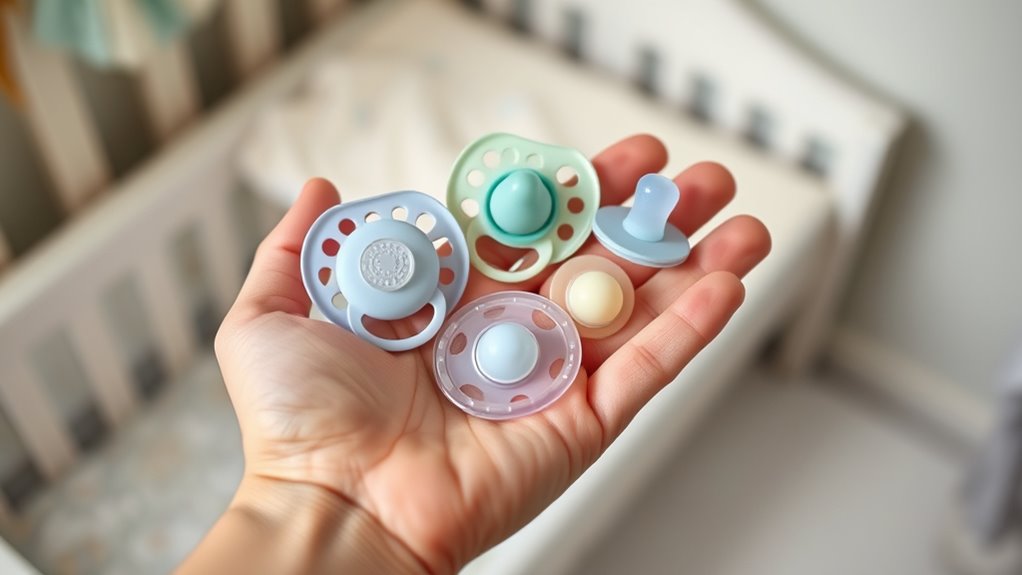
When selecting a pacifier, you need to take into account material compatibility to ensure it’s safe and comfortable for your baby. Choosing the right size is equally important to prevent choking and promote proper oral development. By paying attention to these factors, you can find a pacifier that suits your baby’s needs perfectly. Additionally, considering material safety standards can help you choose products that are free from harmful substances and suitable for your child’s health. Furthermore, considering meditation techniques can help parents manage stress and promote a calm environment for their child. Using a pacifier made from safe and non-toxic materials can further ensure your baby’s safety and peace of mind.
Material Compatibility
Choosing the right pacifier for your baby depends heavily on the material it’s made from, as different types offer varying benefits and considerations. Silicone is durable, easy to clean, and compatible with breastfeeding, making it a popular choice. Natural rubber offers a softer feel and may ease teething discomfort, but it’s less durable and can cause allergic reactions. Latex is flexible and comfortable but wears out faster. Consider your baby’s needs: if they have sensitive skin or allergies, silicone is safest. For teething relief, rubber or latex might be better. Here’s a quick comparison:
| Material | Durability | Breastfeeding Compatibility | Best for |
|---|---|---|---|
| Silicone | High | Yes | Long-term use, easy cleaning |
| Natural Rubber | Moderate | Yes | Teething discomfort |
| Latex | Moderate | Yes | Softness, comfort |
| Polyurethane | High | Limited | Durability, safety |
| Silicone & Rubber blends | Varies | Yes | Versatility |
Additionally, selecting a pacifier made from safe, non-toxic materials ensures your baby’s safety during use. Proper maintenance and regular replacement are also crucial to maintaining hygiene and safety for your infant.
Appropriate Size Selection
Selecting the right size and type of pacifier guarantees your baby’s comfort and safety. It’s essential to choose a size that fits your baby’s age and mouth to prevent choking or dental issues. Smaller sizes suit newborns, while larger ones are better for older infants. Always prioritize pacifier hygiene by regularly cleaning and inspecting for wear or damage. Cultural perspectives can influence pacifier choices, with some cultures favoring specific shapes or materials. Keep in mind that an appropriately sized pacifier minimizes jaw development problems and ensures your baby can suck comfortably. Proper size selection supports your baby’s well-being and promotes safe, soothing comfort. Additionally, understanding anatomical development can help guide the appropriate pacifier size for your child’s growth stages. Being aware of sucking reflexes and how they evolve can further inform your choice, ensuring the pacifier remains beneficial rather than disruptive. Recognizing cost considerations can also assist parents in selecting durable and affordable options, balancing safety and budget.
Techniques for Introducing a Pacifier Successfully

Introducing a pacifier successfully often depends on timing and approach. You should wait until breastfeeding is well established to guarantee compatibility and avoid nipple confusion. Offer the pacifier during calm moments, like after feeding or when your baby shows signs of teething discomfort. Gently introduce it by letting your baby hold and explore it, encouraging natural acceptance. Keep the initial introduction brief and positive, avoiding force or pressure. If your baby resists, try again later or during a different moment. Consistency helps, but be patient; some babies need time to accept the pacifier comfortably. Remember, a gentle, relaxed approach combined with timing that aligns with your baby’s cues increases the chances of successful introduction. Utilizing appropriate storage solutions can also help keep the pacifier clean and ready for use, supporting your efforts. Understanding artistic communication can be analogous to how parents interpret their baby’s cues, enhancing the effectiveness of introducing new items like pacifiers. Additionally, being aware of AI’s impact on customer experience can help parents better understand and respond to their baby’s needs through improved observation and communication techniques.
Monitoring and Managing Pacifier Use to Support Development
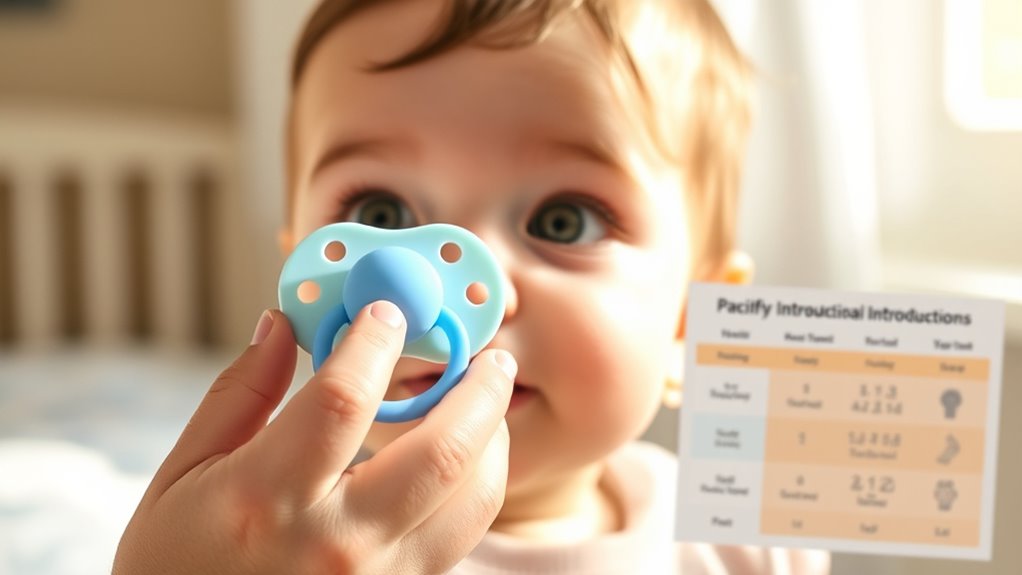
Once your baby has accepted a pacifier, it’s important to monitor how they use it to support healthy development. Keep pacifier hygiene top of mind—regularly clean and inspect it for damage to prevent infections. Be aware of cultural perceptions surrounding pacifier use, as they influence how you handle your child’s habits. Limit prolonged use to prevent dental issues and dependence. Observe your baby’s comfort and response, ensuring they’re not overly reliant on it. Additionally, understanding the potential impact on dental health can help you make informed decisions about pacifier use.
Tips for Weaning Off the Pacifier When the Time Comes
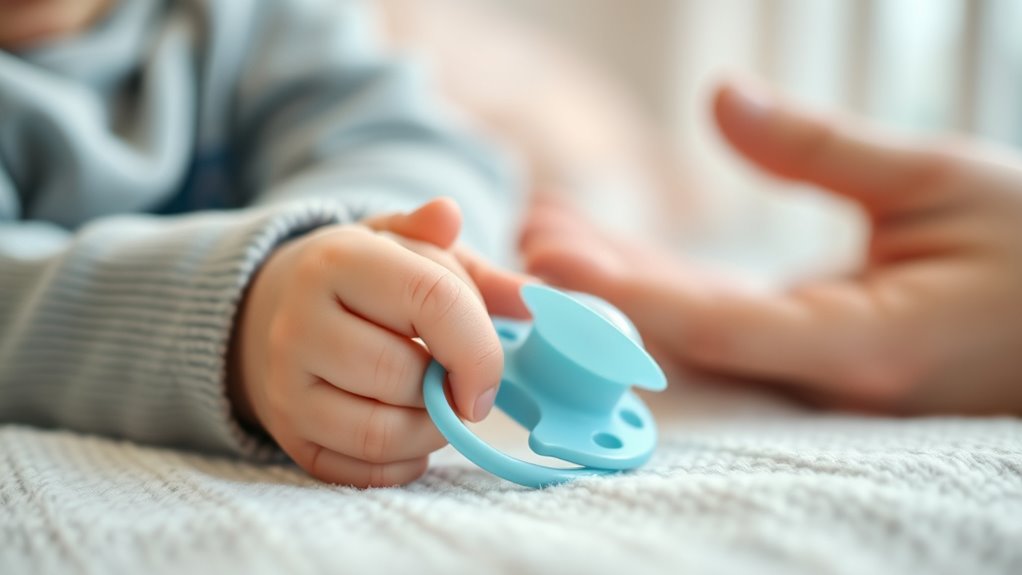
When it’s time to wean your baby off the pacifier, approaching the process gradually and with patience makes it smoother for both of you. Start by limiting pacifier use to specific times, like nap or bedtime, to reduce dependency. Offer teething relief alternatives, such as teething toys or cold washcloths, to help soothe discomfort without the pacifier. Communicate gently with your baby, explaining that they’re growing up and don’t need the pacifier as much. Replace the pacifier with other calming aids, like cuddles or a favorite blanket, to provide comfort. Remember, consistency is key—stick to your plan and give your baby time to adjust. With patience and gentle support, you’ll help your little one transition successfully.
Frequently Asked Questions
Are There Any Health Risks Associated With Pacifier Use?
Yes, there are some health risks associated with pacifier use, mainly safety concerns like choking hazards if the pacifier breaks or becomes loose. To minimize risks, you should practice good hygiene, regularly sterilize the pacifier, and check for damage. Avoid tying pacifiers around your baby’s neck, and don’t let your child use a pacifier for extended periods, as it can affect dental development.
How Do I Prevent Nipple Confusion When Introducing a Pacifier?
Nipple confusion affects about 20-25% of breastfeeding infants. To prevent it, introduce the pacifier after breastfeeding is well established, typically around 3-4 weeks. Always choose a safe pacifier and guarantee proper fit. Keep breastfeeding sessions consistent, and avoid substituting with the pacifier during early feeds. This approach promotes pacifier safety and helps your baby distinguish between the breast and the pacifier, reducing confusion.
Can Pacifiers Interfere With Breastfeeding Success?
Pacifiers can interfere with breastfeeding success if used too early or excessively, as they may disrupt your baby’s natural sucking reflex and oral development. You might notice your little one preferring the pacifier over breastfeeding, which can lead to nipple confusion. To avoid this, introduce the pacifier thoughtfully, ensuring breastfeeding is well-established first, and limit use to prevent interference with your baby’s oral development and feeding habits.
What Are Signs My Baby Is Ready to Stop Using a Pacifier?
You’ll know your baby is ready to stop using a pacifier when they show signs of readiness, like gradually losing interest or using it less often. Watch for developmental milestones such as speech development, where excessive pacifier use might interfere. If your baby starts to chew or push the pacifier away, it’s a good sign they’re ready. Trust your instincts and consult your pediatrician if you’re unsure.
How Can I Make Pacifier Weaning Easier for My Child?
Think of weaning as gently guiding your child out of a cozy nest. To make it easier, use gentle techniques like offering comfort through cuddles and praise, rather than pressure. Encourage independence by introducing a special stuffed animal or blanket as a replacement comfort item. Stay patient and consistent, and celebrate small victories. Your calm, encouraging approach helps your child feel safe and supported during this shift.
Conclusion
Now that you know when and how to introduce a pacifier, you’re better equipped to support your baby’s comfort and development. Remember, every baby is different—so trust your instincts and observe their cues. Are you ready to make this small but meaningful decision that could bring big comfort? With patience and care, you’ll find the right balance for your little one’s soothing needs. After all, isn’t your baby’s happiness worth it?
